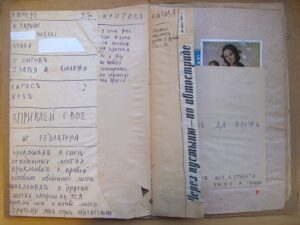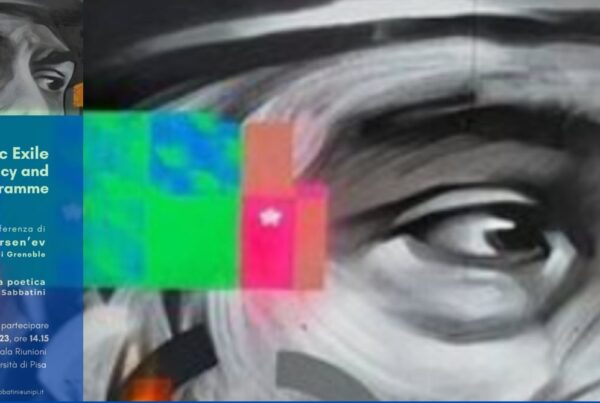
Source: photo by the author.
Title of the journal:
“Nomer” [Number]
Place of publication: Sverdlovsk (now Ekaterinburg)
Editorial board: Ry Nikonova (alias Anna Tarshis), Sergei Sigei (alias Sergei Sigov)
Contributors: Evgenii Arbenev, Valerii D’iachenko, Feliks Volosenkov, Mikhail Tarshis, Aleksandr Galamaga
Total number of issues: 35
Description:
From 1965 to 1973 “Nomer” was the unofficial organ of the Uktusskaia shkola (Uktus School), a circle active in the cultural life of Sverdlovsk in the years following the Thaw. In addition to the founder Ry Nikonova (pseudonym of Anna Tarshis), the group’s members included her brother Mikhail Tarshis, the artists Evgenii Arbenev and Valerii D’iachenko, Feliks Volosenkov and the painter Aleksandr Galamaga, who committed suicide at the age of 21 in 1969. From the fifth of the 35 issues published, Sergei Sigei (pseudonym of Sergei Sigov), a poet who had founded a group of “anarcho-futurists” in Vologda at the beginning of the 1960s, also contributed to the magazine.
Like other samizdat periodicals of the 1960s, “Nomer” was founded on an awareness that for many writers it was impossible to work within the frameworks of official literature, and of the freedom that rejecting such frameworks entailed. As Valerii D’iachenko writes in his appeal at the end of issue 12: “I want the magazine to become in the future the coherent expression of a group of amateurs – artist-amateurs, poet-amateurs, philosopher-amateurs and so on. Or, to be more precise, just amateurs, without any specialisation in the field of art or literature. In other words, there must be room in this magazine for what has no place in life…it is better not to regard culture at all and remain an amateur than to regard it as a semi-professional” (Tarshis 1995: 227). This stance against literary professionalism is also present in a series of articles that appeared in “Transponans”, the magazine that Ry Nikonova and Sergei Sigei began to publish once they moved to Eisk in 1978.
Although the group had regular contact with Leningrad (in 1965, for example, Tarshis enrolled at the local Theatre, Music and Film Institute, where the following year she attempted to stage Eugene Ionesco’s The Chairs), “Nomer” was a mouthpiece for a closed circle of friends, anchored in the city of Sverdlovsk (the Uktus school takes its name from a ski jump in the city). Far from being perceived as a limitation, geographical decentralisation is idealised, as if it were a guarantee of originality and ‘purity’.
As T.P. Zhumati writes, the essential characteristics of “Nomer” – namely rukopisnost’ (handwritten faktura) and odnoėkzempliarnost’ (circulation in a single copy) – lead to a revival of the tradition of the Futurist book, which influenced the form of the samizdat periodical (cf. Zhumati 1995: 127).
“Nomer” was conceived by its editors as an ‘open journal’, programmatically unfinished, whose content depended on additions made by its readers. In fact, from issue 8 onwards, its pages began to contain special columns entitled “Criticism or Criticism of Criticism”, where readers (generally associates of the Uktus School) could freely express their opinions on the published texts. These sections were later joined by blank spaces, isolated from the rest of the page by a simple stroke of the pen and accompanied by imperatives such as “Vpishi svoe”, “klei svoe”, “Ispishi stranitsu” (“Write what you want”, “Paste what you want”, “Cover the page with writing”). The ‘closed’ structure of the periodical edition was thus opened up to the impromptu contributions of its users, transforming itself into an interactive platform, aimed at promoting experiments in collective writing that run parallel to the reading process. As Ry Nikonova herself recalls: “In theory, the magazine could not have a complete form, because it was produced during THE PROCESS OF READING ” (Tarshis 1980: 56).
The readers’ task becomes not so much that of perepisyvat’ (copying, transcribing) the magazine’s contents (as was the case in the traditional samizdat), but that of dopisyvat’ (completing) the contents proposed by the authors, integrating, modifying or distorting what is already fixed on paper to create stratified meanings which in “Nomer” are made visible. One need only think of the visual accumulation in Critica of comments, or of the jumble of newspaper cuttings, drawings, watercolours, collages and removable materials placed in special cardboard pockets (the rubric Vyn’ da vlozh’, “Extract and reinsert”, was introduced in issue 27, accompanied by instructions for use that attempt to regulate the arrangement of the content on the page). The added comments illustrate how the magazine passed from hand to hand within the circle of readers and was completed in a single copy without the intervention of the editors (cf.”Be careful with the drawings!”, 24, 1971).
From issue 30 onwards, “Nomer”, was characterised by its use of finished polygraphical products (technical magazines, catalogues, etc.), some of which were of a foreign origin, which were used to form the pages of the magazine. An emblematic example is issue no. 30 (August 1971), assembled on the basis of a Russian-language periodical on telecommunications, whose title is rendered illegible in an act of what Ry Nikonova would call ‘graphic vandalism’. Inside, its verbal content is obscured, i.e. used as a background for pasting poems or drawings. “Nomer” also appropriated elements pertinent to Soviet material culture: in issue 30, Sigov’s programmatic text, Budetliane i budushchely (1970-71), is handwritten on the wrapping paper of the Sverdlovsk CUM department store (cf. Parisi 2013: 335-338).
All issues of the journal can be found in the samizdat collection of the FSO Forschungsstelle Osteuropa an der Universitat Bremen, Historisches Archiv (Historical Archive of the Centre for Research on Eastern Europe, University of Bremen).
Valentina Parisi
[30th June 2021]
Translation by Diletta Bacci
Bibliography
- Komaromi A. (ed.), Project for the Study of Dissidence and Samizdat, University of Toronto, https://samizdatcollections.library.utoronto.ca/islandora/object/samizdat%3Anomer, online (last accessed: 30/06/2021).
- Parisi V., Il lettore eccedente. Edizioni periodiche del samizdat sovietico. 1956-1990, Il Mulino, Bologna 2013.
- Tarshis A., Ob otkrytom i zakrytom zhurnale Nomer, “Transponans”, 6.2 (1980): 56.
- Tarshis A., Uktusskaia shkola, “Novoe Literaturnoe Obozrenie”, 16 (1995): 221-238.
- Zhumati T., Uktusskaia shkola (1965-1974). K istorii ural’skogo andergraunda, “Izvestiia Ural’skogo gosudarstvennogo universiteta”, 13 (1999): 125-127.
To cite this article:
Valentina Parisi, Nomer, in Voci libere in URSS. Letteratura, pensiero, arti indipendenti in Unione Sovietica e gli echi in Occidente (1953-1991), a cura di C. Pieralli, M. Sabbatini, Firenze University Press, Firenze 2021-, <vocilibereurss.fupress.net>.
eISBN 978-88-5518-463-2
© 2021 Author(s)
Content license: CC BY 4.0





